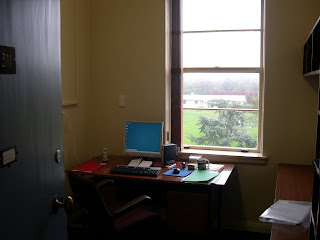I am just starting to understand something of the health system here. There is a nationalized system of health care to cover in-patients with significant subsidies for primary care, so it is a bit of a public/private system. Primary care GP’s practice outside of the hospital, and are considered a lower strata from hospital-based physician consultants (which is my position here). I work with a house physician or house surgeon, roughly the equivalent of an intern or first or second year resident. Some are better than others, some have more experience, and some may be here only months and others years. As a consulting physician, my job entails directing the medical care for hospitalized patients, doing consults on in-patients and out-patients, mentoring the house officers and students that come through, and communicating with other consultant physicians (cardiology, pulmonary, ID, etc.). There is a lot less paper-work as most of it is to be done by the house physicians or registrars.
The system is far from perfect. There is a significant “brain-drain” here because medical students accrue large debts, and Australia and other countries pay significantly more (thus the on-going need for well-trained foreign locums). The system is under-funded, with a smaller slice of the GNP going to health care compared with comparable developed countries, so there can be very long waits for non-emergent problems, such as a 9-12 month wait (or longer) for joint replacements, specialty consultations, MRI’s, if they are done at all. Some specialists such as neurologists are particularly in short supply.
Malpractice is practically a non-issue because years ago New Zealanders passed a national accident insurance plan. There is one large fund to which they all contribute which covers care and compensation from accidents, whether they be vehicular, industrial, or medical.
I feel well-prepared to do this work, having a broad background and have maintained in-patient and out-patient skills. I can see there will be times where I will get swamped with sick patients and would like to have more back-up than I will, but my commitment is just for six months. The country is beautiful, its easy to get around, and the people are friendly. Some of the doctors get together for dinner on Tuesday nights, a nice social and bonding event. I can take night call from my home across the street from the hospital and most things can be handled by phone.
The doctors offices are on the 5th floor of an old nurses school dorm.
I have my own small room, very cozy.There is a kitchen and bathroom with large bathtub across the hall.
It brings back warm memories of the call rooms at Mt. Zion Hospital in my residency days.
The weekend was clear and sunny, so we took the opportunity to see more of the countryside. First we went to Lake Tekapo. The small lakeside church the Church of the Good Shepherd is a famous sight in NZ, and we happened upon its 75th birthday party. HRH Prince Richard, the Duke of Gloucester, was there to help celebrate. Look carefully and you can see Dick on the steps.

His father laid the cornerstone back in the day.
Mt. John observatory overlooks the lake and has a nighttime star-gazing program that we will definately go back to do, but I wanted to push on to get to Aoraki/Mt. Cook National Park before the winter weather really sets in. It was the perfect day to visit. Many days the highest peak in Australasia (3755 m.) is enveloped in clouds but not for us.
(The Maori name Aoraki means "cloud piercer".) We spent the night at the venerable Hermitage Hotel ("arguably the most famous hotel in NZ" according to The Lonely Planet). The view from the room was spectacular. There is also Sir Edmund Hillary Alpine Centre (Ed to his friends)
and a planetarium. The visitor center has a wood carving depicting the native myth of creation of the South Island and Aoraki (overturned canoe, four brothers turned to stone, if you are interested).
 We drove back on a southern route Sunday though beautiful hills and rivers and fall foliage.
We drove back on a southern route Sunday though beautiful hills and rivers and fall foliage.Monday the rains started, and there has been some flooding. Old-timers are a bit nervous because there was some quite serious floods about 30 years ago. Winter is coming.




















































